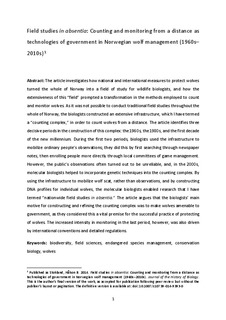| dc.description.abstract | The article investigates how national and international measures to protect wolves turned the whole of Norway into a field of study for wildlife biologists, and how the extensiveness of this “field” prompted a transformation in the methods employed to count and monitor wolves. As it was not possible to conduct traditional field studies throughout the whole of Norway, the biologists constructed an extensive infrastructure, which I have termed a “counting complex,” in order to count wolves from a distance. The article identifies three decisive periods in the construction of this complex: the 1960s, the 1980s, and the first decade of the new millennium. During the first two periods, biologists used the infrastructure to mobilize ordinary people’s observations; they did this by first searching through newspaper notes, then enrolling people more directly through local committees of game management. However, the public’s observations often turned out to be unreliable, and, in the 2000s, molecular biologists helped to incorporate genetic techniques into the counting complex. By using the infrastructure to mobilize wolf scat, rather than observations, and by constructing DNA profiles for individual wolves, the molecular biologists enabled research that I have termed “nationwide field studies in absentia.” The article argues that the biologists’ main motive for constructing and refining the counting complex was to make wolves amenable to government, as they considered this a vital premise for the successful practice of protecting wolves. The increased intensity in monitoring in the last period, however, was also driven by international conventions and detailed regulations. | nb_NO |
